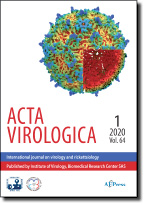Journal info
|
||
Select Journal
Journals
Bratislava Medical Journal Ekologia - Ecology Endocrine Regulations General Physiology and Biophysics Neoplasma Acta Virologica Current articles 2023 2022 2021 2020 2019 2018 2017 2016 2015 2014 2013 2012 2011 2010 2009 2008 2007 2006 2005 2004 2003 Studia Psychologica Cardiology Letters Psychológia a patopsych. dieťaťa Kovove Materialy-Metallic Materials Slovenská hudba 2025Webshop Cart
Your Cart is currently empty.
Info: Your browser does not accept cookies. To put products into your cart and purchase them you need to enable cookies.
Acta Virologica Vol.64, No.1, p.93-99, 2020 |
||
| Title: Targeting Epstein-Barr virus nuclear antigen 1 (EBNA-1) with Murraya koengii bio-compounds: An in-silico approach | ||
| Author: V. MATHIVADANI, A. S. SMILINE GIRIJA, J. V. PRIYADHARSINI | ||
| Abstract: Epstein-Barr virus (EBV), a B lymphotrophic herpesvirus associated with various forms of tumors, exhibits several latency phases with expressed EBV nuclear antigen 1 (EBNA-1). In the search of novel EBV-inhibiting targets, to curb the menace of EBV-borne lymphotropic transformations, EBNA-1 protein might serve as a best target for novel antiviral natural compounds. This study is thus aimed to explore the inhibitory potential of Muuraya koengii bioactive compounds isomahanine, murrayanol and mahanimbine against the EBNA-1 of EBV. 3D structure of EBNA-1 was retrieved from the PDB data bank with further optimization of both the protein and ligands. In-silico inhibitory potential of the selected M. koengii bio-compounds against EBNA-1 as well as the molecular properties of the derivatives against EBNA-1 were assessed. Murrayanol seems to be a potent inhibitory drug to target EBNA-1 with a promising binding energy of -7.21 with two hydrogen bonds. Drug likeliness parameters recorded murrayanol to be the most promising of the tested compounds, followed by isomahanine. Molecular docking evaluations show that EBNA-1 might be inhibited with M. koengii biocompounds. |
||
| Keywords: EBV; EBNA; M. koengii; in-silico | ||
| Published online: 11-Mar-2020 | ||
| Year: 2020, Volume: 64, Issue: 1 | Page From: 93, Page To: 99 | |
| doi:10.4149/av_2020_111 |
||
|
|
 download file download file |
|

